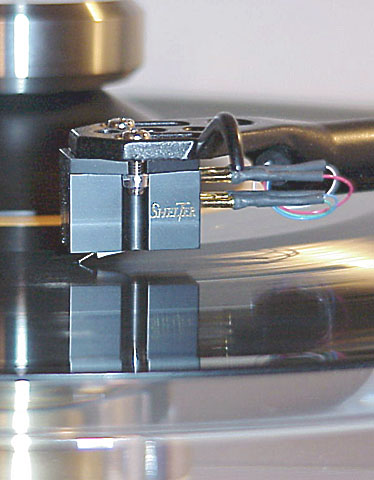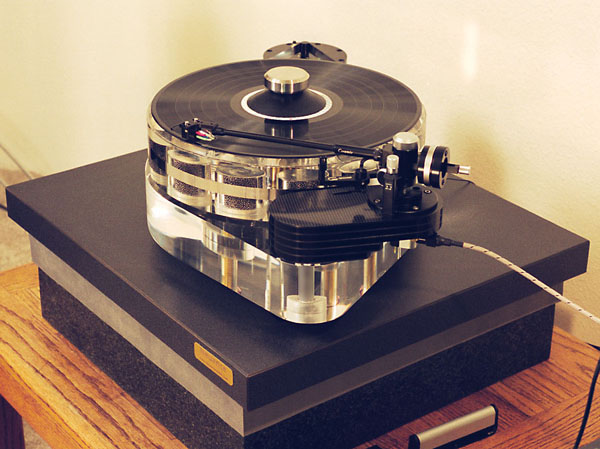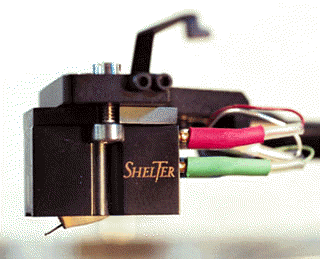-edible zone-
Review: Shelter 501-II moving coil phonograph cartridge
Date:
2/5/2003/updated 12/2005
Author: Steve Clarke
Model: 501-II
Category: Phono Cartridge, MC
Suggested Retail Price: $800 at time of
review....$850 in 2005
Description: Moving Coil Phonograph Cartridge
Manufacturer URL: none
Manufacturer: Shelter Inc., Yasuo Ozawa sole
proprietor
Made in Japan
Distribution: Eifl (export) (Japan),
Axiss USA (import) In the US, Shelter carts are distributed through
Axiss to the dealer network.

Above: photo of this Shelter 501 type II in the Express Machining
RB250 tonearm.
Warranty: one year warranty
Specification:
output voltage: 0.4mV, stylus: elliptical, tracking force: 1.4g to 1.8g,
DCR: 12 ohm, step up trans: within 10 ohms, head amp: within 100 ohm,
frequency response: 20hz to 20khz +- 2db, Cantilever: "Cantilever is not
covered by 1 year warranty. Please do not break it." Adjustment:
"SHELTER recommends to change stylus pressure within recommended
tracking force (1.4g to 1.8g) in summer and winter. in summer: .1g to
.2g less, in winter .1g to .2g more"
Mounting and Aligning:
Mounting is a nut and bolt arrangement. Overhang and Zenith
alignments were set with the 2 pt. protractor supplied with the HFNRR
test record. VTF was set with a Shure SFG-2 scale at 1.7g. Alignment was
verified with the HFNRR test record.
The cartridge is mounted to
an Express Machining /Rega RB250 tonearm with full structural and wiring
mods. Note-worthy is the Shelter's performance in the anti-skate portion
of the HFNRR Test Record. It passed track 6 (300 hz at +12db) and track
7 (300hz +14db) , and then buzzed lightly on track 8 (+16db) then loudly
on track 9 (+18db). VTA was set over the course of several days using
the adjustable VTA feature of the Express Machining tonearm.
The
user manual fails to mention any compliance figure of the cantilever and
it's suspension, but the HFNRR test record measurment indicated the
arm/cart resonance to happen at 11 hz. in the lateral, indicating an ok
match-up between the modified Rega arm and the Shelters' rather short
cantilever.
Mounted in this arm, the Shelter does indeed appear
to be a low compliance cartridge. As the stylus is gently cued onto the
vinyl, there is very little evidence of suspension travel in either
vertical or lateral planes as the cantilever absorbs the full effective
mass of the arm. It really is kind of awkward finding the lead-in
groove, the way it abruptly snaps in, sometimes making a pop/snap
through the speakers. The solid boron cantilever is a short, stiff
little bugger and, no doubt, this particular design trait plays largely
into the sound this cartridge produces.
Associated equipment:
- Turntable: Teres model 135 with Expressimo RB250 tonearm.
- Turntable: Teres model 145 (lead shot platter upgrade year 2004)
- Tonearm: Graham 2.2 acquired October 2005
- Phono cable: Silver Incognito
- Turntable Mounting: Welded tubular steel wall rack,
- Turntable Mounting: Short stout table on the floor weighed down with a heavy granite plate.
- Shelf: Neuance Beta Shelf
- Phono stage: Wright WPP100C with 1:10 (Souter) step up to meet loading and gain needs (100 ohms, .4mv) of the Shelter
- Integrated Amplifier: Classe' CAP 151 (150 watts rms per ch.)
- Speakers: NHT 2.9
- Interconnects: silver IC from phono stage to Integrated amp.
- Speaker Cables: Monster 2R-CL 12/2
- Length of evaluation: 4-1/2 years.
Impressions:
The Shelter 501-type 2 sports an anodized
black-colored machined-aluminum body. It's shape is boxy and rectangular
with sharp right-angled corners, reminiscent of Koetsu. There are two
open slots for tonearm mounting in the top plate and two machined
recesses to clear bolts in the body sides which must be used to secure
this cartridge. There is a gold colored center-line on the front panel
indicating stylus location to assist cueing. The Shelter name resides on
one side of the body and the text reads "Model 501 Japan" on the
opposite side, also in gold color. The bottom is completely open. The
generator is covered in a white gauze. The stylus is elliptical and nude
mounted to an aluminum-clad solid Boron cantilever which looks to be
rather short in length. Viewed from the side in profile, the cantilever
appears to make a rather steep angle down to the record surface. This
cartridge has an understated and classy appearance.
Right out of
the box the Shelter sounded drop-dead gorgeous on my system. Even though
there is mention of a break in period, I never experienced significant
change in the tone of this cartridge due to any loosening up of it's
internals.
Most apparent is the liquidity, sweet melody and an
alive sense of presence in the midrange. There is no coloration. The
music is presented natural and alive. Vocals have richness and texture
suggesting intimate proximity to the singer. In jazz recordings, the
acoustic bass is revealed to be the vibrating, resonating wood box that
it is. You get the edge of loose vibrating strings, the faster solid
body of the note, the sound of the resonating wood box and a trail-off
as the note dies slowly. Trumpets and sax's take on the individual
character of the player. It's easy to differentiate between Coltrane or
Mobley. Coltrane's tenor sax has a somewhat dissonant tone leaving a
slight aftertaste in memory. Mobley's tenor is much sweeter and more
typical of the instrument. The Shelter makes it easy and obvious to
distinguish between the two players, allowing this listener to get
closer and experience these two great masters. Percussion has speed of
attack and crispness. The sharpness of hard stick against wood block
cracks into the atmosphere. Cymbals ring out prominently, shimmering,
resonating and hanging in air.
Piano music. There have been
moments when a full sized Grand Piano apparently crowded itself into my
listening room. Usually this happens when I'm not listening intently,
catching me off-guard. For me, this could be the Shelter's most striking
attribute. It does acoustic piano surprisingly real. Just as good as it
does the human voice.
In the Alan Parson's Lp "Pyramid" , the
track "Pyramania", the Shelter renders a 'gong crash' exploding, popping
upward out from the left speaker then arcing down toward the floor at
center stage, then dying a slow decay. The 30 hz. organ note covering
the floor of "Also Sprach Zarathustra" (RCA LM-2609) as performed by The
Chicago Symphony, Fritz Reiner conducting, is delivered softly, but it
is present and apparent. I imagine a subwoofer might help to add some
force to such low frequency notes, yet the Shelter does offer extension
down into the lower frequencies all the time producing details of timber
and texture, and the air around it. Bass is tight and accurately
described with enough weight to satisfy most audiophiles.
Highs
are served up in natural detail. There appears to be no roll off that I
can hear as the higher frequencies are explored. Flutes, piccolo's
violins playing in their upper registers appear vibrant and with purity
of tone. There isn't any apparent coloration that I can detect or
perceive. The highs go strong all the way up with no harshness or
unnatural edge.
________________________________________________________horizontal rule
There has been some miss-tracking. The "problem Lp" is Paul Simon,
"Still Crazy After All These Years". Song: "50 ways to lose your lover".
The problem area is in the vocal refrain with the words: "You don't need
to discuss much..." When he sings "...discuss much..." there is a buzzy
break-up to Simons' voice, a kind of light buzz that matches the pitch
frequency of those notes and intrudes upon the vocal at that highest
dynamic peak.
I had noticed this for some time when playing the
record with the Shelter. I had always just chalked it up to groove wear
and continued to search for a cleaner copy of the record. The problem
with that thought is that this record is a NM/NM item. When I finally
did find another one, just as clean, there was the same miss-tracking
effect. At a later time I mounted a newly acquired Denon DL-103R
cartridge to the arm and played the same track. --It played clean! --
Problem identified, the Shelter was miss-tracking those particular
grooves.
The tonearm at this time was an Express Machining RB250.
Later I got the Graham 2.2 and went through the same motions on "50
ways...". Same effect. Even in the Graham, the Shelter miss-tracked "50
ways to leave your lover". But not so with the DL-103R. When, still
later, I acquired the MC Jubilee, one of the first records played was
this one. No miss-tracking with the Jubilee, either.
Thoughts
running through my head about the Shelter included the possibility of a
grunged-up or, maybe, 'gasp', a worn stylus. I use a stiff Discwasher
stylus brush -dry- between each play. That keeps the nude mounted
diamond elliptical stylus mainly clear of "cling-ons". However at one
time I dismounted the cartridge then used my 30x pocket microscope to
examine the cartridge. I carefully brushed it till the diamond appeared
clean and transparent through the scope. Then I remounted the cartridge.
That did improve overall sonic performance on all records, but
unfortunately it still miss-tracked "50 ways..".
Three years
usage should put it at roughly 1/2 of its life-span, I figure. It still
played all the other records cleanly like it had when it was newer. So
my conclusion is that the Shelter will miss-track over difficult
grooves. That's just part of the party. You take the truly magical
aspects of the Shelter along with its warty problems.
______________________________________________horizontal rule
One attribute that many listeners look for in a phono cartridge is the ability to display massed instruments, in dense passages, coherently while allowing the individual instrument within the mix to be perceived by the listener. It is here, I think, where most high end audio systems display an inherent weakness. Recordings of large orchestral works tend to sound like scaled down versions of themselves, and are not mistaken for the live event. In this test, the Shelter has not set itself apart from the crowd. Of course the associated gear plays just as much a role in this performance as does the review item and this trait significantly changed when I added the Graham 2.2 tonearm to the system this year in October (10/2005). While dense passages were still, well....dense, there was indeed greater definition within the passage without losing any sense of coherence. The Graham was a significant upgrade and served to augment all of the Shelter's positive attributes while reducing its shortcomings. An excellent match-up, the Graham and the Shelter, I think.

 (click thumbnail for full size image)
(click thumbnail for full size image)
In this system, with classical music, I find the Shelter at its best
while rendering chamber music such as Vivaldi's 4-Seasons, or Bach's
Brandenburg Concertos, or Beethoven piano sonatas. Chamber music is
quite effective. Piano concertos come across convincingly as the Shelter
renders piano realistically. Harpsichord music can come alive, depending
on the recording.
Summary:
- Strengths: Extended natural highs. Liquid, natural, melodic and a magically-alive midrange. Tight, detailed, articulate lower frequencies.
- Weakness: With some "problem records" it may show a tendency to miss-track high amplitude record grooves.
- Best musical category: Small combo jazz, chamber music, piano sonatas, harpsichord, folk music, acoustic blues and vocals.
- What about Rock..?: It rocks good..! It also displays, without
mercy, just how well or poorly your classical rock group was
recorded. In general, this cartridge renders rock and roll to my
satisfaction. The Stones on London/Decca are rendered with beautiful
detail and clarity, because they were recorded well. The Beatles,
particularly during their more complex period, but even the early
material is spectacularly reproduced. Hendrix.....? Good but there
was some intentional distortion in his recordings and this also is
reproduced with clarity. Same with Led Zeppelin, but on the whole
Led Zep's transitional passages are produced with very dynamic
impact and to great satisfaction. 'Into sixties psychedelic...? Try
Donovan's "Sunshine Superman". The Shelter reproduces Donovan's
music just fine, thank you. Folk Rock..? Simon and
Garfunkel...again, the Shelter is very good with vocals.
End of Review
